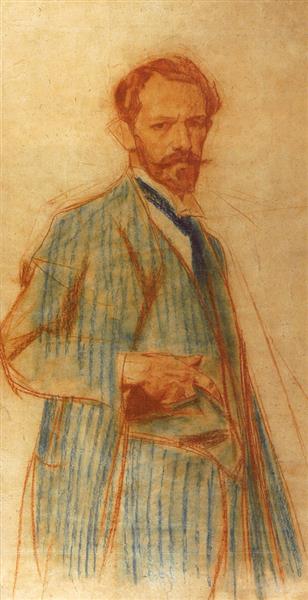Description
The work "self -portrait" of Oleksandr Murashko is a notable manifestation of introspectionism that characterizes many of the self -portraits of the late nineteenth and early twentieth century. When observing this piece, not only a visual testimony of the artist's appearance is perceived, but also a deep exploration of his emotional state and identity as a creator. Murashko, a Ukrainian painter, enrolls within the Nationalist Art Movement that sought to show the culture and aesthetics of his homeland, while absorbing influences of impressionism and realism.
The composition of the self -portrait is notable for its simplicity and its evocative force. Murashko's figure is located in the center of the painting, Drapeada in a dark clothing that contrasts with a clear background, almost nebulous. This use of contrast suggests a game of lights and shadows that not only defines the artist's physical contours, but also suggests an introspection. Murashko's gaze is penetrating and contemplative, inviting the viewer to a connection beyond the simple observation; It seems to be in a silent dialogue with the observer, questioning his own existence and, by extension, the one who looks.
The color plays a crucial role in the work, where the earthly and soft tones combine with the white and gray of the background. This generates an atmosphere that suggests both melancholy and hope, a reflection of the tensions of its time. The skin of the self -portrait, modeled with subtle brushstrokes, transmits freshness and vitality, while the eyes, highlighted by its intensity, function as the main focal point of the work, revealing a psychological depth that invites interpretation. The choice of colors and their disposition manifest Murashko's technical ability, as well as its deep artistic sensibility.
Murashko is part of a tradition of self -portraits that dates back to masters like Rembrandt and Van Gogh, who also used their own faces as a mirror of their own anguish and triumphs. However, Murashko's approach is distinctive, since its self -portrait is inserted in a national context where the search for cultural identity and personal expression are vital. The painting, which dates from approximately 1890, is not only the representation of an individual, but becomes a symbol of the aspiration of a nation towards artistic and cultural recognition.
The technique used is characterized by a masterful use of light, as well as a loose brushstroke that, despite the apparent informality, reveals a meticulous consideration in the construction of the image. There are no other characters in the painting, which intensifies the sense of loneliness and isolation that emanates from self -portrait, a recurring theme in Murashko's work and an echo of the artistic experience of his time.
In conclusion, the "self -portrait" of Oleksandr Murashko is presented as a work rich in meaning and technical, which goes beyond mere physical representation. Through its emotional exploration and mastery in the use of color and light, Murashko manages to capture the essence of its being, establishing a vital connection with the viewer that lasts beyond the temporal and cultural limits. This work is undoubtedly a enduring testimony of the search for identity in a broader artistic context, reflecting both the artist's personal struggle and the collective aspiration of his nation.
KUADROS ©, a famous paint on your wall.
Hand-made oil painting reproductions, with the quality of professional artists and the distinctive seal of KUADROS ©.
Art reproduction service with satisfaction guarantee. If you are not completely satisfied with the replica of your painting, we refund your money 100%.

